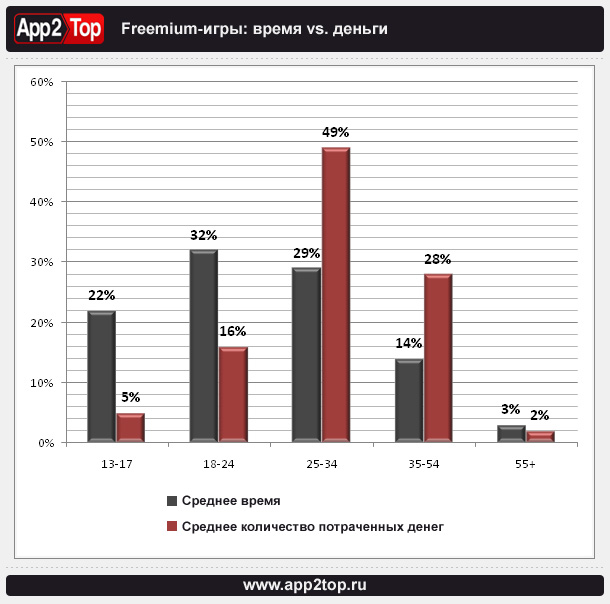Mobile freemium games: some play, others pay
Freemium-games on the iOS and Android app market remain the main source of profit. For example, free games from the top 100 games on the App Store bring 65% of all revenue.
As for the target audience of freemium games, all users can be divided into two groups: those who just play and those who make purchases inside the games. The article uses data from Flurry Analytics, which has studied more than 20 million smartphones based on iOS and Android and registered just under 1.5 billion actions over 110 thousand free applications. What were the results?
The graph shows how much playing time and money was spent by one or another age group on freemium games.

The gray color indicates which age groups spend the most time on freemium games. It can be seen that the most active players are users from 18 to 24 years old (32%), followed by players 25-34 years old (29%). Age groups such as 13-17, 35-54, and 55 share the rest of the temporary traffic – 22%, 14%, and 3%, respectively. The average consumer age, according to time indicators, was 26.6 years.
The red color indicates how much, on average, the same users spent on in-app purchases in the same games. Players aged 25-34 (49% of the total amount) brought the largest profit to companies, consumers aged 35-54 (28%) were in second place. For comparison, the most loyal players (18-24 years old) occupy only the third place in terms of funds spent, only 16%. Teenagers from 13 to 17 years old, for whom these games are designed, brought only 5% of the profit. Payments of players over 55 years old amounted to 2% of the profit. The average consumer age of those who make purchases inside free apps was 32.2 years.
In general, it can be noted that those who just play freemium games are younger than those who spend money on them. Young players (13-24 years old) they are more willing to play (55% of temporary traffic) than to buy virtual parts (21% of profit). Older players (25-34 years old), on the contrary, pay more than they play (49% of profits and 29% of the time). Of course, these figures directly depend on the category of the game, as well as on the time and money limit.
To advance through the levels and earn game points in social games, the user can use “grind”, a set of basic game functions. As a rule, it takes time and patience. Those who have a lot of time (or little money) can (or should) be patient. This option is just right for players of school and college age. For them, “grind” is something that can and should be put up with. Playing more often than others, they easily become regular users, but do not bring profit to development companies.
On the other side of this scheme are players 24-35 years old. They have more income, but less time, because they have work and family responsibilities. Sometimes they don’t have time to play for a long time, and they prefer to gain promotion through the levels. Note that the age group from 24 to 54 already brings 4/5 of the total profit of freemium games.
In conclusion, it should be said that your clients may be older than you think. After all, as it turned out, some play, and others pay.